Carry gun optics are rapidly becoming the standard. At least in the courses I attend, almost all of the instructors are using red dot optics on their pistols, and about half of the students are. Rifles and carbines either have red dots or low power variable optics, with red dots still making up the majority on the carbines. Very few of the “tactical shotgun” courses use the red dot, but I see that changing as well.
As the market expands, every company that makes an optic has gotten in on the game, some with much better products than others. Unsurprisingly, Leupold, a long venerated name in magnified optics, has released a night vision-capable version of their DeltaPoint red dot optic, the DeltaPoint Pro Night Vision. This pistol/rifle/shotgun red dot combines all of the features of their previous DeltaPoint offerings, now with outstanding night vision capability, all wrapped in typical Leupold quality.
I keep trying red dot optics on my pistols, mostly with a GLOCK 19, and keep choosing to stay with my irons. Even on guns I’ve shot daily with a red dot for months, when I put them on the timer, I’m still no faster and no more accurate with the red dot than I am with a decent set of iron sights, according to the timer.

The rifle, carbine and shotgun, however, are entirely different matters. I’m both faster and more accurate with a red dot optic, out to 300 yards, than I am with even the best iron sights on the market. That’s because a red dot optic reduces the number of focal planes from three all the way down to just one, when compared to irons.
Most folks have an advantage with a red dot over magnificent optics, including low power variable optics, as they require no real consideration of parallax. The big benefit there is that you can shoot from non-standard positions and with no concern for eye relief or head position. If the dot is on the target, that’s all you need (ballistic arc being ignored).
If you’ve never tried a red dot optic on a semi-auto shotgun, you owe yourself to give it a shot. With the right round and the right choke, 50-yard shots into an 8″ target with OO buckshot become no challenge at all. (As an aside, for those of you in law-enforcement who think you’ll never need to use a shotgun at that distance, go measure the distance from the trunk of your cruiser to the door of the cab of a semi you’ve stopped.)
The DeltaPoint Pro Night Vision (NV) can be mounted on a pistol, rifle, or shotgun through a wide variety of available mounts. Leupold offers these directly. These include dovetail bases for well over a dozen different semi-auto pistol models, Smith & Wesson revolvers, Picatinny and Weaver rail mounts.
There are scope-top ring mounts, QD rail mounts, and even an adjunct rear iron sight. Leupold will likely take a whole lot of market share simply because of the wide range of factory mounting options available. If you are unsure of what your specific firearm needs, just call them directly.
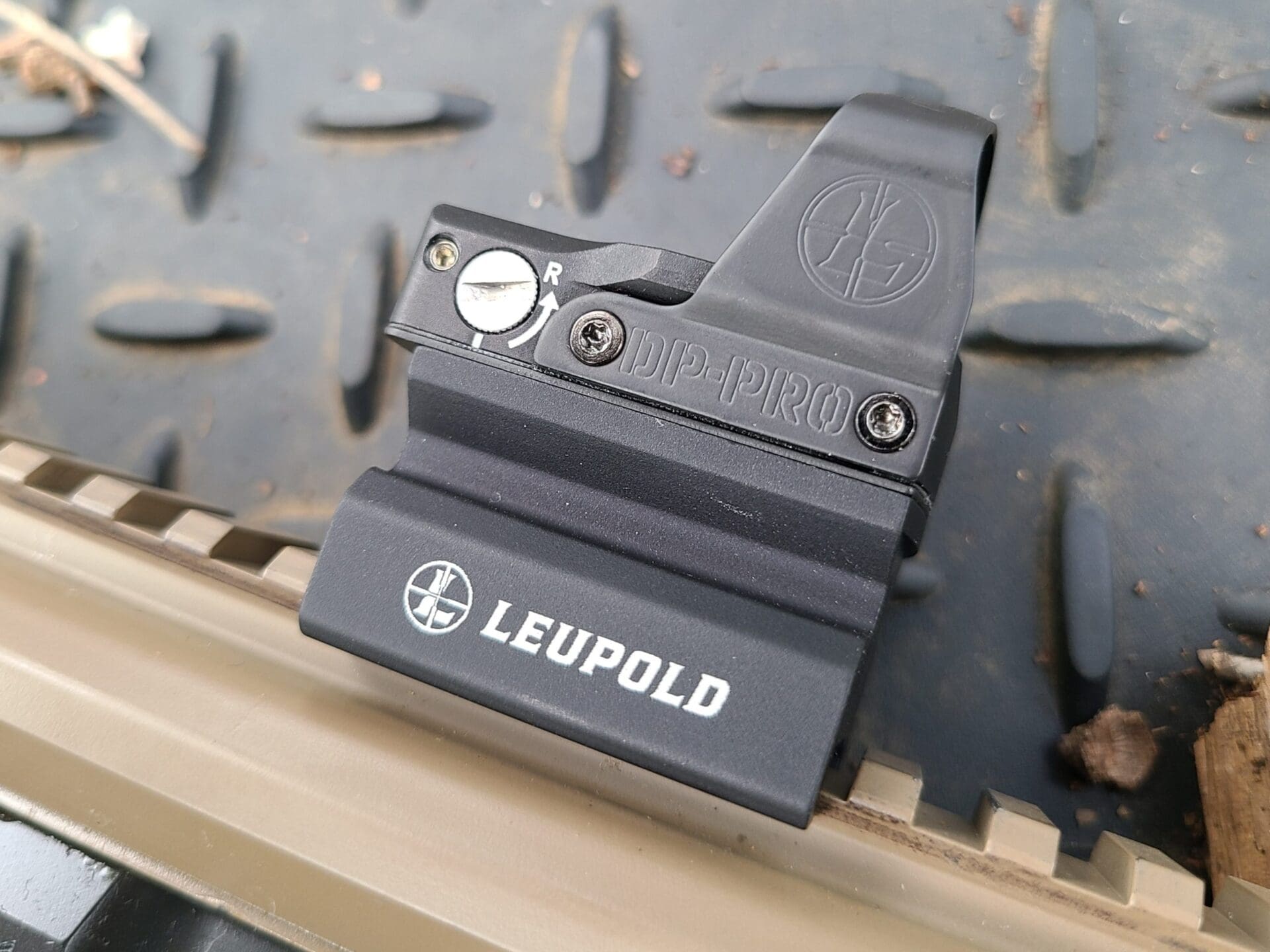
Using the standard (non-QD) AR mount, I put the DeltaPoint Pro NV on a few different guns for this review. They included a SIG MPX in 5.56 NATO, a SCAR 20S in 7.62×51 NATO, an Underground Tactical .458 SOCOM SBR, and the gun I probably shoot the most, an integrally suppressed M&P 15-22.
There’s not much to operating the DeltaPoint Pro NV. There’s a windage screw, an elevation screw (either of which can be rotated with the rim of a casing), and a single button for on/off and brightness. Other than mounting the optic, which requires a couple of torx wrenches (supplied) the only tool that would be required to adjust or operate the DeltaPoint Pro NV is that casing.
The single button interface is both a feature and a challenge. It’s a bit of a challenge scrolling through the 10 different brightness settings one at a time. You can switch the direction of change, and increasing brightness occurs at larger increments than decreasing.
The benefit of the single button is that, well, it’s just one button. It’s large, it’s right in the middle, and it’s simple to use in light or darkness.
I am simple. I like simple things. Products designed to operate under stress should be extremely simple. This one is. As an added benefit, the single center button is large enough to activate even with a gloved finger.
Beneath that button is a single 3 volt CR2032 battery. Installation is tool-less, fast, and easy to do, even in the dark.

I can’t find any literature from Leupold that states how long that battery is supposed to last on different settings, but I talked with two different instructors who use this optic on their pistols. Both of them said they never turn it off and use it every day. Both report swapping out the battery a couple of times a year as part of their user maintenance, but neither said they had ever actually seen the battery die or the image dim.
If anyone has real experience or data on how long the battery lasts, please let us know in the comments.
The DeltaPoint Pro has a battery-saving auto-off/auto-on motion feature. If the optic is turned on and then is still for five minutes, it goes into sleep mode. As soon as it’s moved, it turns right back on to whatever the setting was when it went to sleep.
To test the sensitivity of the sleep mode and the battery life, I took the mounted optic on the rifle and simply set it in the back seat of my truck anytime I wasn’t using it. That way I could look in and see if it was on or off. The movement of the vehicle was enough to keep it on, but it turned off if the vehicle was stopped for over five minutes.
After a month of use now, I’ve noticed no change in the brightness of the dot.
Just to make sure there’s truth in advertising, I stuck the optic — still attached to the upper receiver of a SIG MCX Virtus — in a freezer overnight. Turning it back on, not only did it work just fine but there was no discernible shift in point of aim or point of impact. That was a -16 to 90 degree Fahrenheit temperature swing. I also dunked it in the sink for a minute. It showed no malfunctions and didn’t stop working.

There are two different reticles offered by Leupold. Most folks using the Delta Point Pro for a pistol will likely choose the 7.5 MOA chevron. The large reticle is easy to find when shooting fast, and the point of the chevron can still be used for precise aiming. As I prefer to use the red dots on long guns, I prefer the 2.5 MOA dot.
As long as I’m wearing my glasses, the dot is crisp and round. At its highest setting, the dot is also very clear and bright even in the harshest sunlight. There’s no searching around for it on a bright target. Alternatively, I can choose to step it down bit by bit to get as small a dot as possible for longer, more precise shots.
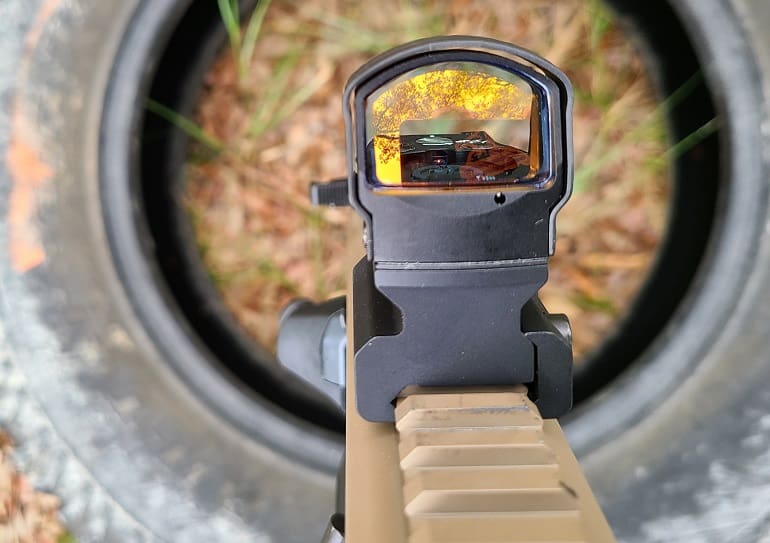
There is a very slight bluish tint to the optic glass. It would be easy to miss the tint at all unless you’re in bright outdoor light. As it is, the tint wasn’t distracting at all, and didn’t dim or diminish the view through the optic enough to matter.

The construction of the DeltaPoint Pro is plenty robust. Everything on the outside is metal. The plastic housing over the glass is itself shrouded in a single piece of stamped metal, which has a thin gap between it and the plastic lens housing. It’s obviously going to be shock proof for recoil, but the general construction makes it fairly impact resistant as well.
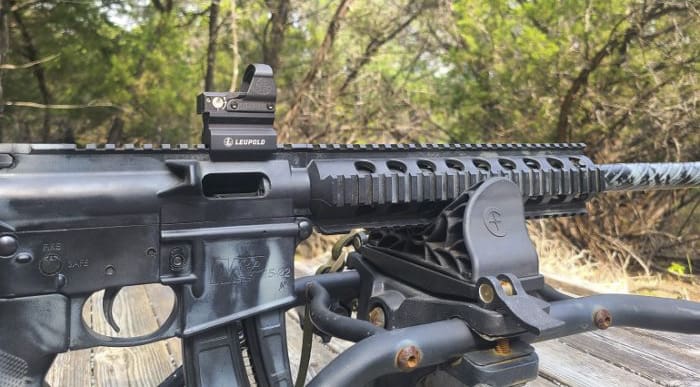
My standard for recoil testing for most optics is pretty simple. I mount it on my .458 SOCM SBR and push 15 rounds of heavy, max pressure rounds through it as fast as I can. The DeltaPoint Pro passed that test, so I also mounted it directly above the ejection port on my SCAR 20S and put 50 rounds through it.
I have never experienced the scope-breaking issues some folks have had with the SCARs and I didn’t with the DeltaPoint Pro NV either. Rimfires have this same reputation, for some reason that I don’t understand. The DeltaPoint Pro NV, mounted on top of my suppressed M&P 15-22 and in front of an AN PVS-14 monocle is my favorite combination as it’s a nighttime varmint murder machine.
In short, I never had any issues with the DeltaPoint Pro NV on any platform.
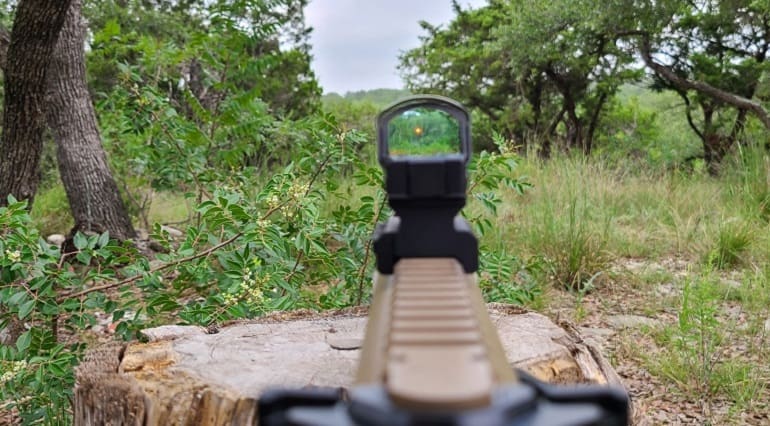
At 1.82″ tall and 1.31″ wide, the Delta Point Pro has a relatively wide field of view compared to most of the smaller red dot optics. There’s no issue at all in looking right through the optic and maintaining a solid view of the target, as well as what’s around the target.
This is one of the huge advantages of the red dot optic, and especially the small format optics. When done right — and the DeltaPoint Pro is done right — the shooter is able to maintain situational awareness unmatched by iron sights or magnified optics. That’s especially the case for shooting on the move. Other sighting systems, including iron sights, obscure more of the environment in front of the muzzle while the shooter is looking through the sight.
Many new shooters, or those who’ve been improperly trained, get in the habit of lowering the firearm when scanning for threats. I’m not sure where, or why, this practice developed. I assume it’s because folks wanted to get in the habit of checking for additional threats, but didn’t have a range that would allow them to do that while pointing their gun around. This is a bad habit.
Looking through the glass, scanning for, acquiring, and firing at the threat is a natural and instinctive process through the DeltaPoint Pro. For any new shooter, it’s ideal. It’s just as ideal for the experienced shooter focused on mobility and rapid target acquisition.
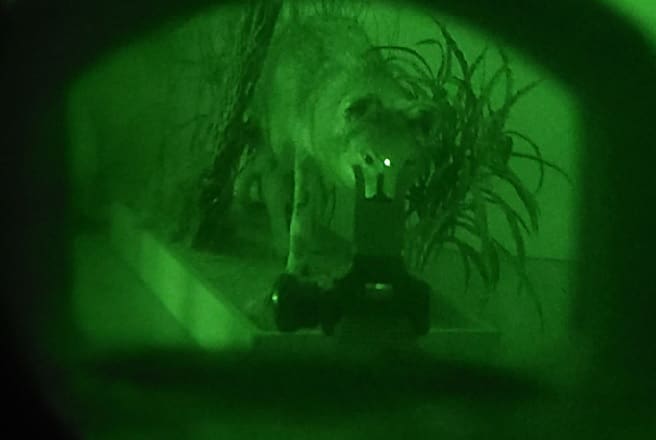
I’ve taken a look at quite a few of these smaller red dot optics now, and none of them have done the night vision setting as well as the night vision-capable DeltaPoint Pro.
The night vision settings are simply the lowest two brightness levels for the optic. What sets this apart from others is that the aiming dot remains crisp, without any kind of light flaring of halo effect. If you’ve ever used an AN-PEQ 4 – PEQ15, it looks just like the tiny crisp dot those devices present on the target.
There are still huge advantages to using an infra-red laser aiming device, such as team target identification, visual communication, and non-standard firing positions. But if your only real goal is targeting at night, the Delta Point Pro NV is the less expensive option.
Either mount NV binoculars or a monocle on your head, or a monocle behind the DeltaPoint Pro NV on a rifle, and you’ll have the same sight and sight picture day or night, rifle, shotgun, or pistol.
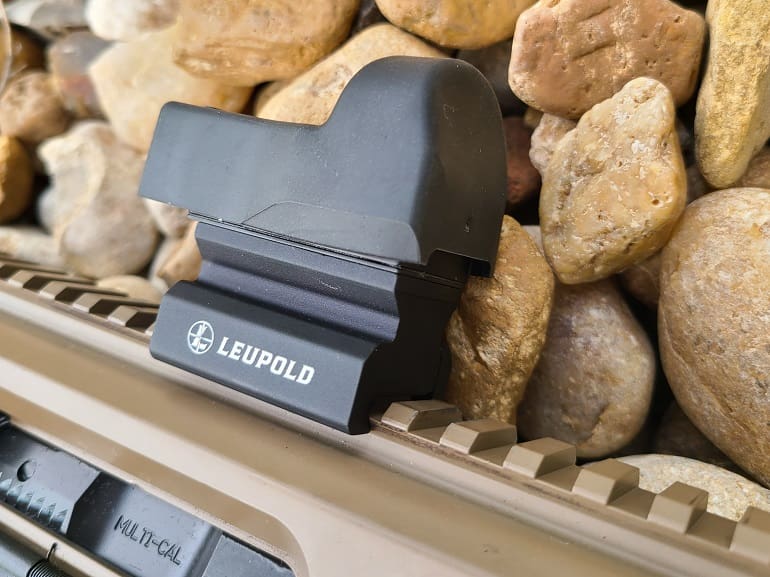
The DeltaPoint Pro comes with Leupold’s lifetime guarantee. It simply states that if the optic “…doesn’t perform, we will repair or replace it for free–whether you’re the original owner or not”. I’ve used Leupold’s customer service for optics in the past, and although sometimes I’ve had to wait a month to get a product back, I’ve had only good experiences with them.

No matter what the platform, the DeltaPoint Pro is a pretty great option. The performance is excellent, it’s simple to use, and clearly rugged enough to handle the job. It’s also pretty great that it works well enough on multiple platforms, so you could have the exact same sight picture and experience no matter what gun you’re running.
Specifications: Leupold DelaPoint Pro NV
Reticle: 2.5 MOA Dot or 7.5 MOA Chevron
Battery: CR2032
Weight(oz):1.95
Length(in):1.82
Weight(g):41
Elevation Adjustment Range(MOA):60
Windage Adjustment Range(MOA):60
Width(in): 1.3
Height(in): 1.3
MSRP: $584.99 (about $499 retail)
Overall * * * * 9/10th
The Leupold DeltaPoint Pro NV is durable, reliable, and has the best night vision capability of any of the optics of its type on the market. It’s window-licker simple to operate and Leupold includes a multitude of mounting options right form the manufacturer. It’s an ideal multi-gun red dot optic. My only complaint is that battery life information should be more readily available.

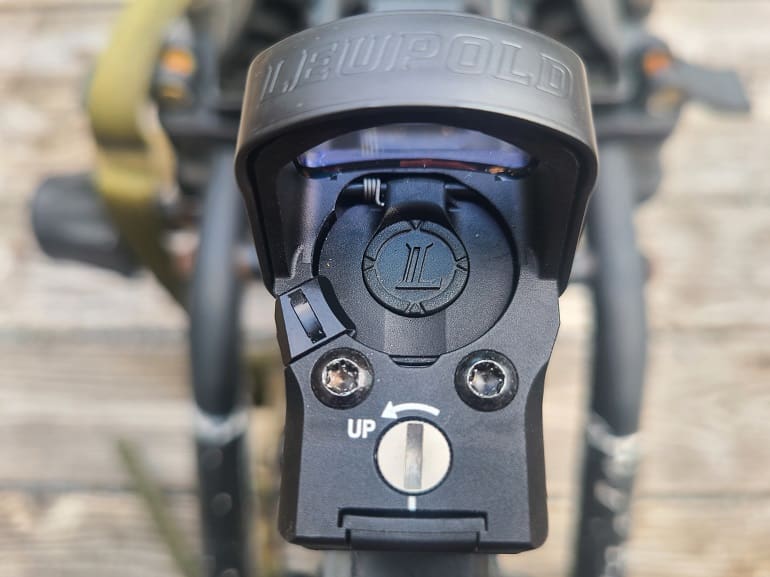



Not sure I want my optic to say DP-PRO on the side in big letters. Someone didn’t think that through.
You’re not up with something akin to a Dutch Door Professional? *snicker*
Virgin.
Yup, I must be in good company here with the others that have never known the pleasure of a woman. Thanks troll! 😁
Good review. I love me some Leupold! Every scoped rifle I own wears a Leupold. Two pair of their Gold Ring binoculars and a Gold Ring spotting scope. Can’t begin to remember how many have passed through my hands. But. No thanks to the red dot. On anything. The focal plain thing on rifles is a non issue on rifles with peep/ghost ring sights. You look through the rear sight, but otherwise ignore it. That leaves the front sight post and the target. Two things. Same as the red dot. Except there’s no batteries and a lot less to break on a set of steel sights. Murphy is alive and well. Especially in a gunfight. Shotgun? No thanks, unless I’m shooting at a feathered fiend. Distance from a patrol car to the tractor on a semi rig. Ok. First, a rifle is just as effective at 50 as 150 yards. And I don’t care what load your using. That pattern is really starting to open up at 50 yards. My experience with the red dot on handguns parallels the author’s. As an aside, I’m sure it may have happened, but I don’t recall a single gunfight between a professional driver and an LEO.
Gadsden Flag,
I stick to iron sights on my “battle” platforms for the exact reasons that you stated.
And I am especially concerned about battery performance. Several times throughout my life I have pulled out a device which uses batteries and the batteries prevent the device from working properly. Most often that is due to batteries corroding. Other times I simply forget to change the batteries which often lose their life after sitting around for 5+ years. Still other times, I unintentionally left the device on or something bumped the “on” switch to the “on” position and that killed the batteries.
Gadsden,
My deer rifles are all equipped with Leupold glass. Iron sights for all carbines and handguns, except for a specialized AR with a red dot.
I almost cried like a baby when I “fumble fingered” and accidentally dropped a brand new Leupold I’d brought home, and the protective metal lip just outside the glass rim dented when it hit the concrete floor. I re-purposed it as a backup spotting scope.
Haz, call Leupold. Lifetime guarantee on
Gold Ring. Don’t know about fumble fingers. Never had a Leupold fail. I did leave two scope adjustment caps at the range one day. I called them and asked for replacements and my cost. No internet in those days. Three days later I had six scope turret caps in the mail. No charge. Never mind the cost. Quality second to none. Customer for life.
“I don’t recall a single gunfight between a professional driver and an LEO.”
Come work the Mexican border and you’ll see plenty.
jwt, I’ll defer to your expertise. However, that just reinforced my choice of a rifle. Shotguns are for hunting small feathered tasty birds. Rifles are for killing things that might kill you. No one will ever change my mind about that.
Not trying to. The reality is that some departments are still rolling with pump guns and you’d better be good with what you’ve got.
Oh! Forgot to mention. That is a good point about eye position behind the red dot. Red dots have it all over all sights in that respect. It’s just that one advantage doesn’t tip the scales for me. But then, that’s just me.
I still prefer EOTech.
enuf, that’s great thing about capitalism. Buy what you want. Even if you’re wrong.
No, doesn’t work that way. You get to buy what you want and be right both times. I’ve an EOTech holo sight on one of my AR’s and a Bushnell red dot that I move between other long guns. What’s cool is by noting the number of clicks this and that way on each, both come back to center just fine when I make a swap.
enuf, that’s great! Bet your life on things that have more options to fail. We’ll never meet and if either of us die the other will never know. I just choose to stick with things that have fewer options to fail. I don’t look as cool, but my shit always works. Or, always has. Can’t say the same for many of my friends that bought wi-fi, high tech wait until I change my battery, adjust my dot brightness, figure out how to switch to the real sights I should have been using to begin with. It will only take a minute.
Optics on handguns are either generally for 1) to look “cool” and make it like a video game or 2) because they can’t be bothered to learn to shoot with iron sights.
Keep your gimmicks. As if handguns needed yet another protrusion to hang on something when drawing.
Red, 👍.
Most professional shooters would disagree with you. There’s a reason there’s a “carry optics” division and most competitions. That’s because it’s such a huge advantage for most shooters over iron sights.
If you are like me, and can’t shoot optics any faster than you can shoot irons, it’s not because you’re really good with irons. It’s because you’re not very fast with anything.
If your optic is catching on something when you draw your gun, you don’t know how to draw a gun.
You are 100% correct and almost did a spit-take when I read that comment. The only people who get nothing out of optics-equipped pistols either 1) aren’t all that good with pistols to begin with or 2) don’t put in the time to get good with them. Once you’ve figured them out, there’s no comparison, they are BETTER than irons-only guns.
Jerry Miculek would disagree.
Jon Wayne. Most professional shooters I’ve met, and I’ve met one or two, don’t carry on the street what they shoot in a match. Mount a refund dot on whatever you want. Anyone can. Your money. Your life. I wouldn’t walk across the street for a free red dot. Again, just me.
Even 2 years ago I might have agreed with you. But not anymore. Times change, equipment changes, and tactics should change right along with them.
My experience also differs from yours. Most of the professional shooters I know that put an optic on a pistol for competition change their carry gun to match in short order.
jwt, you and I know different people.
“The plastic housing over the glass is itself shrouded in a single piece of stamped metal, which has a thin gap between it and the plastic lens housing.” — JWT
I just checked the Leupold site and they claim that the construction is all aluminum and steel. Maybe the black anodized aluminum looks a bit like black plastic?
Yep, the housing is all aluminum and the shroud is steel.
Tommy, I’m sure you’re right. Doesn’t make any difference to me. Love Leupold, but it could be made of depleted nuclear titanium uranium it’ll kill you if I point it at you wonder shit. No red dots, batteries, on/off switch, brightness adjustments, or one more fucking thing that can go wrong. Period. If you give me half a chance while you fiddle with your shit, I’ll make you hate your life.
Did your spell checker confused “magnificent” with “magnifying”?
Comments are closed.